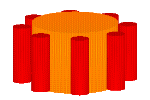

Floyd Sweet claims to have obtained over unity electrical energy effects by applying a special magnetization process to some ferrite magnets. His setup consisted of one or more specially conditioned magnets and at least 2 coils. The magnets are fixed (stationary). One coil was used to excite or begin the oscillations of the magnets with a small AC field. The other coil(s) were used to "pick up" the magnet's large magnetic oscillations. (Clearly a non-linear effect occurs here for the excitation AC magnetic field is small compared to the output.)
See, for example, Alan Dubla's web pages and this article for a more detailed description of Floyd Sweet's devices.
I have also investigated Prof. John Searl's magnetic motor/generator. After spending a couple of years volunteering my time with D.I.S.C. Inc. USA to help Prof. Searl reproduce his device according to his explanations and instructions, I have not been able to figure out by what physical bases Prof. Searl claims his devices worked. (Note: I have not worked directly with Prof. Searl. However, the group working here in the USA was in direct and frequent contact with Prof. Searl.) He has developed a construction method which he calls "The Laws of Squares" which, in my opinion, is so far removed from the language of physics and engineering that one is left completely in the dark as to the cause of the motion in his devices. We are therefore free to think up our own methods and explanations for constructing a device in which magnets are "self-propelled".
Here is a ruff illustration of Searl's setup. For more detail on Searl's devices see the info at this web site or just search the web.


What is most interesting for the following comparison is the similarity (but not perfect match) between Sweet's method of conditioning the magnets and Searl's magnetization process. In both cases, an AC field is applied to the material. (There is more detail, of course, to both Sweet's and Searl's magnetization process. I am only pointing out the most obvious similarity here.)
So, is there a way to use Sweet's effect to produce a Searl-like magnetic motor?
Consider "large" but "slow" magnetization vector oscillations cohered (in sync) to produce traveling waves. It would then be possible for the wave to "pull" (or "push") a disk magnet along with it. This is illustrated in the next figure in which a disk magnet (red) moves along a magnetization vector oscillation traveling wave.

If such waves can be created around a cylinder (or ring) then it might be possible to move the stacks of disks around this center cylinder.
In Sweet's work, a small AC excitation is needed to begin the larger magnetization oscillations. Applying this concept to the Searl-like arrangement, the disks rolling around the center cylinder would be "seen" by the center cylinder as small "excitation" magnetic oscillations.
Searl says that his first devices needed to be "started". That is, the stack of disk magnets need an external source to start them rolling. This could have excited large magnitude oscillations in the center cylinder in a similar way that Sweet's small excitations started the large magnetization oscillations in his magnets.
One problem that I see with this arrangement is that I would not expect the wave length to be so large that the disks fit between wave crests. I would expect the wave length on the center cylinder to be much smaller. Then it is doubtful that the disks would be carried along.
This may be why Searl claims that both the center cylinder (actually, its a ring in Searl's set-up) and the disks need to be specially magnetized (conditioned). The result may be another magnetization wave around the disks. These waves in the disks coupled with the wave in the center cylinder may be like two gears in which their teeth mesh. (Searl says that the frequency used to magnetize the disks is not to be the same as that used for the center ring. So it is not clear whether or not this "gear" analogy is appropriate.)
In a static condition (that is, considering the center cylinder alone with no disks around it) The magnetization vector wave might "stop" (might not be traveling around the cylinder) but it might retain its alternating "pattern" around the periphery of the cylinder. This might be the origin of the "pattern" that Prof. Searl claims is measured around his center ring.
Both Sweet and Searl claim that once the oscillation started and they extracted energy from their devices the magnets would become very cold.
I have read that in ferromagnets, the magnetization vectors of the material are constantly oscillating. But the oscillations are chaotic/random. Sweet may have found a way to cohere or "order" these oscillations with a non-linear oscillating result. And Searl (independent of Sweet) might be using these oscillations to "carry" the stacks of disk magnets around the center cylinder.
It is claimed that another researcher by the name of Hans Coler was also able to induce "large" oscillations in ferromagnets. I don't think there was any kind of special "magnetization" process involved, but I could be wrong.
As far as I can determine, "large" scale coherence of magnetic oscillations is not known to exist in "large" magnets. (But then neither are the over unity effects produced by Sweet, Searl and Coler!)
On the other hand, "small" coherent oscillations are know to exist in magnetic material.
If you want to read up on magnetic oscillations, take a look at the following books.
These books mention the use of a DC magnetic "bias" field together with an AC magnetic field being applied to the magnetic material sample to induce various kinds of oscillations. This technique is called "parallel pumping". It is clear, to me, that AC magnetization techniques have been applied to small sample magnetic material now for many years. But the science folks don't seem to have applied such techniques on the "large scale" as have Sweet and Searl.
Usage Note: My work is copyrighted. You may use my work but you may not include my work, or parts of it, in any for-profit project without my consent.